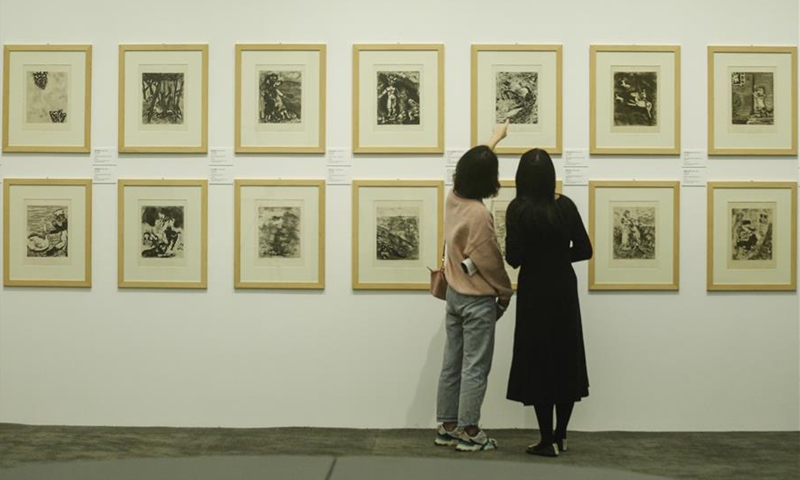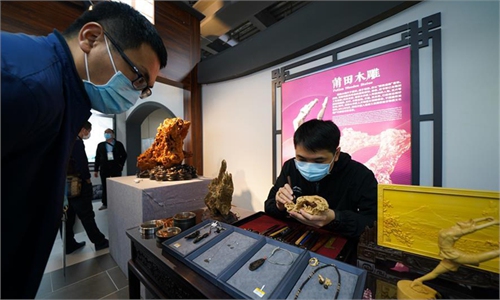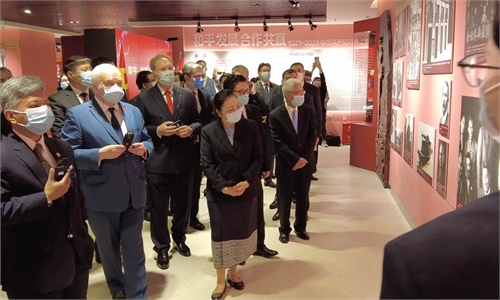ARTS / CULTURE & LEISURE
Cultural exhibitions rising in popularity among young Chinese

People visit an exhibition on Marc Chagall at the Langfang branch of CAFA Art Museum, in Langfang, north China's Hebei Province, Oct. 10, 2020. Consisting of 155 creations, an exhibition on Russian-French artist Marc Chagall is held from Oct. 9, 2020 to Jan. 18, 2021 here. (Xinhua/Zhang Yuwei)
As the number of exhibitions in China has nearly tripled in recent years, museums and art galleries are becoming the hot new place to gather together among young Chinese.
The number of temporary and permanent exhibitions has increased nearly twofold in recent years according to public data. Roughly 29,000 exhibitions were held across the country from August 2020 to August 2021, based on a report from the China News on Sunday, comparing this to the 11,033 exhibitions held in 2019 according to data from the China Convention and Exhibition Society.
"If you look at the comparison, this increase is pretty good," an experienced curator based in East China's Jiangsu Province told the Global Times, noting that the number of exhibitions increased by an average of 1,000 annually over the past decade in China.
Insiders say that young people today think highly of the cultural industry, and when coupled with the increase in platforms for young Chinese artists to display their works, this has set the stage for "an exhibition boom."
The Global Times reached two exhibition lovers and a curator to ask their thoughts on the matter.
Wu Chen, a 25-year-old working in the publishing industry in Beijing, just returned from an immersive exhibition featuring the art of Van Gogh.
The show, undertaken by a company called Grande Experience, had toured more than 70 cities before it landed in Beijing.
Wu said she had greatly anticipated the show ever since she heard that it was coming to the capital and bought a ticket the second day they became available.
She described how popular the exhibition was in China, "By the time I bought my ticket nearly 8,000 tickets had already been sold online." Wu studied in London for a year in 2019 when she noted herself falling in love with the art exhibitions since then, and often goes out with friends to search for more interesting exhibitions from time to time.
In addition to Western exhibitions coming to China, young Chinese have also been showing a greater interest in exhibitions of traditional Chinese culture. Shan Jixiang, former curator of the Palace Museum in Beijing, once told media that in 2019 the museum marked "the first time that people under 35 exceeded 50 percent of all visitors."
Another exhibition enthusiast surnamed Zou, who works in the internet industry, wants to explore traditional collections. She noted that the Palace Museum is her favorite place.
"I noticed that in recent years, the museum has been holding very large-scale exhibitions," Zou said, adding that she thinks this is an excellent idea to attract the attention of young visitors to the "once unappreciated pavilions that had been collecting dust in history."
In addition to efforts by China's traditional museums, more curation companies have taken notice of the power of young artists and their modern art, and so have been working to provide them with a platform.
"We are like a bridge. These young artists have the most interesting ideas when viewing this society in their artistic way and try to convey the problems they have spotted in the form of art," the Jiangsu-based curator told the Global Times.

People visit an exhibition on Marc Chagall at the Langfang branch of CAFA Art Museum, in Langfang, north China's Hebei Province, Oct. 10, 2020. Consisting of 155 creations, an exhibition on Russian-French artist Marc Chagall is held from Oct. 9, 2020 to Jan. 18, 2021 here. (Xinhua/Zhang Yuwei)
As the number of exhibitions in China has nearly tripled in recent years, museums and art galleries are becoming the hot new place to gather together among young Chinese.
The number of temporary and permanent exhibitions has increased nearly twofold in recent years according to public data. Roughly 29,000 exhibitions were held across the country from August 2020 to August 2021, based on a report from the China News on Sunday, comparing this to the 11,033 exhibitions held in 2019 according to data from the China Convention and Exhibition Society.
"If you look at the comparison, this increase is pretty good," an experienced curator based in East China's Jiangsu Province told the Global Times, noting that the number of exhibitions increased by an average of 1,000 annually over the past decade in China.
Insiders say that young people today think highly of the cultural industry, and when coupled with the increase in platforms for young Chinese artists to display their works, this has set the stage for "an exhibition boom."
The Global Times reached two exhibition lovers and a curator to ask their thoughts on the matter.
Wu Chen, a 25-year-old working in the publishing industry in Beijing, just returned from an immersive exhibition featuring the art of Van Gogh.
The show, undertaken by a company called Grande Experience, had toured more than 70 cities before it landed in Beijing.
Wu said she had greatly anticipated the show ever since she heard that it was coming to the capital and bought a ticket the second day they became available.
She described how popular the exhibition was in China, "By the time I bought my ticket nearly 8,000 tickets had already been sold online." Wu studied in London for a year in 2019 when she noted herself falling in love with the art exhibitions since then, and often goes out with friends to search for more interesting exhibitions from time to time.
In addition to Western exhibitions coming to China, young Chinese have also been showing a greater interest in exhibitions of traditional Chinese culture. Shan Jixiang, former curator of the Palace Museum in Beijing, once told media that in 2019 the museum marked "the first time that people under 35 exceeded 50 percent of all visitors."
Another exhibition enthusiast surnamed Zou, who works in the internet industry, wants to explore traditional collections. She noted that the Palace Museum is her favorite place.
"I noticed that in recent years, the museum has been holding very large-scale exhibitions," Zou said, adding that she thinks this is an excellent idea to attract the attention of young visitors to the "once unappreciated pavilions that had been collecting dust in history."
In addition to efforts by China's traditional museums, more curation companies have taken notice of the power of young artists and their modern art, and so have been working to provide them with a platform.
"We are like a bridge. These young artists have the most interesting ideas when viewing this society in their artistic way and try to convey the problems they have spotted in the form of art," the Jiangsu-based curator told the Global Times.


